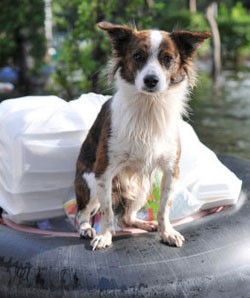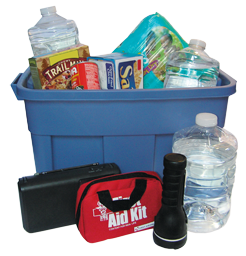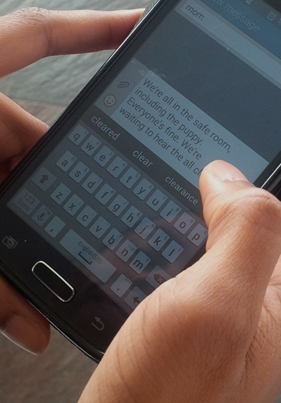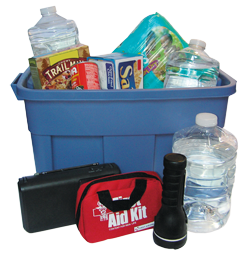Preparedness
Emergency Preparedness and Response
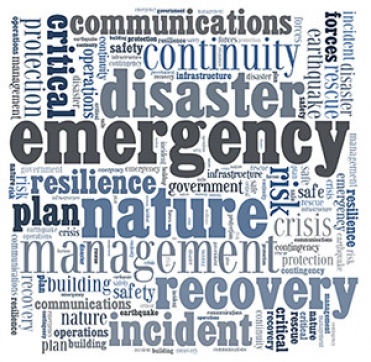
Preparing Makes Sense.
Get Ready Now. (cdc.gov)
1. Get a Kit
2. Make a Plan
3. Be Informed
1. Get a Kit of Emergency Supplies
If a disaster strikes in our community, you might not have access to food, water, or electricity for several days. You may think that you will have enough time to run to the grocery store, but stores quickly sell out of important supplies following emergency warnings. Unfortunately, about half of adults in the United States do not have the resources and plans in place for a possible emergency. Preparing emergency kits for your family is an important step in keeping them safe and healthy during a disaster.
Pack an emergency supply kit. Here's what you'll need:
At Least a 3-day Supply of Food and Water
- Water - one gallon per person, per day
- Food - foods that are easy to make and won't spoil, like canned soup, dry pasta, and powdered milk
- Manual can opener
- Basic utensils to prepare and serve meals
Health Supplies
- 3-day supply of all medicines, at a minimum
- Medical supplies like syringes, a walking cane, or hearing aids with extra batteries
Personal Care Items
- Soap
- Toothbrush and toothpaste
- Baby wipes
- Contact lenses or glasses
Safety Supplies
- First aid kit
- Emergency blanket
- Multipurpose tool (that can act as a knife, file, pliers, and screwdriver)
- Whistle
Electronics:
- Flashlight
- Radio (battery-powered, solar, or hand-crank) for updates on the situation
- Cell phone with chargers
- Extra batteries
Documents
- Copies of important documents such as insurance cards and immunization records
- Paperwork about any serious or on-going medical condition
- Your completed family emergency plan, complete with family and emergency contact information.
You should also keep
- Extra cash
- Maps of the area
- Extra set of car keys and house keys
Taking Care of Others
You may need additional supplies to make sure the whole family is ready.
For Children
- Baby supplies like bottles, formula, baby food, and diapers
- Games and activities for children
For Pets
- Food and Water:
- A 3-day supply of food and water for each pet. A cat or a dog will generally need 1 gallon for three days.
- Bowls or bottles
- Manual can opener
- Cleaning Supplies:
- Depending on the pet, you may need a litter box, paper towels, plastic trash bags, grooming items, and household bleach
- Health and Safety:
- Medicines and medical records stored in a waterproof container
- First aid kit with a pet first aid book
- Transport supplies:
- A sturdy leash, harness, and carrier to transport pets safely. A carrier should be large enough for the animal to stand comfortably, turn around, and lie down. Your pet may have to stay in the carrier for several hours.
- Comfort Items:
- Pet toys and the pet's bed, if you can easily bring it, to reduce stress
- Paperwork:
- Current photos and descriptions of your pets to help others identify them, and to prove that they are your pets, in case you become separated from them
- Information on feeding schedules, medical conditions, behavior problems, and the name and telephone number of your veterinarian in case you have to board your pets or place them in foster care
Keep these tips in mind!
Personalize
Every family is unique. You may have emergency needs not included in this list. Also, remember to update your kit according to changing needs of your family.
Be sure it's ready to use
In a disaster situation, you may need to get your emergency supply kit quickly, whether you are sheltering at home or evacuating.
- Once you have gathered your supplies, pack the items in easy-to-carry containers.
- Clearly label the containers and store them where you can reach them easily.
- Remember that certain items, like medications and paper documents, need to be kept in waterproof containers.
Keep it Fresh
Check the expiration dates on food, water, medicine, and batteries at least two times per year. It's extremely important that all items in your kit are functional at the time of an emergency.
Involve Children
Families can make emergencies less stressful by preparing in advance and working together as a team. Ready Wrigley can help! Find out more about Wrigley here!
- Ask your kids to think of items that they would like to include in an emergency supply kit, such as books, games, and pre-packaged foods.
- Your kids can mark the dates on a calendar for checking emergency supplies. Tell them to remind you when it's time to check the supplies.
- Include kids in planning and creating disaster kits for family pets.
Know Your House
Find out where your gas, electric, and water shut-off locations are, and how to turn them off.
Prepare For Everywhere
Emergencies can happen anywhere. Remember to prepare supplies for home, work, and vehicles.
2. Make a Plan
Protect yourself and your loved ones by making an emergency plan. You should make a plan for:
- How you will contact one another, and
- What special steps you will take in different types of emergency situations.
Make a Family Communication Plan
You and your loved ones may not be together when a disaster hits. Make a plan for how you will connect to each other. Start by taking the following steps:
- Complete a contact card for each family member. Everyone should keep these cards with them at all times.
- Choose an emergency contact. Memorize the phone number if you can. A friend or relative who lives out of town might be easier to reach in an emergency. During an emergency, family members can text or call this person to let them know that they are safe.
- Make sure all your family members know how to text. Make sure everyone knows how to turn on a cell phone, find the text messaging app, type a message, and send it to a contact.
- Know emergency telephone numbers. Keep them in your cell phone and post them near your home phones. Some good numbers to have are your emergency contact, the fire department, police station, and hospital near you
Make a Family Disaster Plan
Before making your disaster plan, its important to know what types of emergencies are likely in your area and the best way to respond. For example, if tornadoes are common in your area, you will need to know what the warning signs are and where to take shelter. Check with your Local Red Cross chapter or Emergency Management Agency for more information.
- Find the safe spots in your home for each type of disaster. For example, during an earthquake you will need to "drop, cover, and hold on" under a sturdy desk or table. However, during a tornado, you would need to seek shelter in a lower level room without windows. Learn more about different types of disasters.
- Choose multiple meeting places. Different disasters may require you to go to different places. Make sure you choose a meeting place in your neighborhood, a meeting place just outside your neighborhood, and a meeting place out of town.
- Determine the best escape routes from your home. Find two ways to get out of each room.
- PRACTICE.Review these plans with all members of your family. Practice your disaster plans by running drills with the whole family.
- Don't Forget Pets! Think about what you would do with your pets, because they may not be allowed in emergency shelters. For more information, check out Preparing Your Pet for Emergencies.
Get your kids ready
- Teach children how and when to call 911 for help.
- Quiz your kids on the plan to make sure they remember what to do.
- Include your kids in planning and drills.
Ready Wrigley can help your kids be ready for many kinds of emergencies!
Take these additional steps to be prepared
- Make an emergency kit, and be sure to check and replace your supplies throughout the year, as needed.
- Stay informed; find the best ways to get disaster information from local authorities.
- Make sure that you have enough insurance coverage for your property. Specifically, think about the types of disasters that are common in your area.
- Learn how and when to turn off the water, gas, and electricity at the main shut-off locations.
- Show each family member how to use the fire extinguisher, and show them where it's kept.
3. Be Informed
There are many ways that authorities share emergency warnings, updates, and safety instructions. Take steps now to make sure you’ll get the information you need when an emergency happens.
Stay Informed
Check with your local emergency management agency to find out what kinds of emergencies could happen in your area. Then:
- Find out how to get local emergency alerts. Check with your local health department or emergency management agency to see how they share emergency information. Some places use:
- Emergency texts
- Phone calling systems
- Digital road signs
- Social media
- Sirens and speakers
These are in addition to emergency alerts sent by the federal government.
- Learn about your community’s warning signals. Be able to recognize what the warning signals sound and look like and what you should do when you hear or see them.
- Tune in. Listen to and watch reliable news sources. Keep a weather radio handy.
Watches and Warnings
In addition to understanding how you will be informed of potential threats, you need to understand the terms that are used for weather threats.
- A watch means that there is a high possibility that a weather emergency will occur. When a severe storm watch is issued for your area, continue to listen to the radio or television for updates and pay attention to visible weather changes around you.
- A warning means that a weather emergency is already happening, or will happen soon. When you hear a warning, take immediate action


